Study of Acoustic Prototypes Based on Plastic Cap Waste
Abstract
:1. Introduction
2. Materials and Methods
2.1. Panel Design
2.2. Acoustic Characterisation—Evaluation of the Airborne Sound Insulation
2.3. Acoustic Characterisation—Evaluation of the Sound Absorption
3. Results
3.1. Evaluation of the Airborne Sound Insulation—Sound Reduction Index, R(dB)
3.2. Evaluation of the Sound Absorption
4. Conclusions
Author Contributions
Funding
Data Availability Statement
Conflicts of Interest
References
- Asdrubali, F.; Schiavoni, S.; Horoshenkov, K.V. A Review of Sustainable Materials for Acoustic Applications. Build. Acoust. 2012, 19, 283–312. [Google Scholar] [CrossRef]
- Balmori, J.-A.; Casado-Sanz, M.; Machimbarrena, M.; Quirós-Alpera, S.; Mostaza, R.; Acuña, L. The Use of Waste Tyre Rubber Recycled Products in Lightweight Timber Frame Systems as Acoustic Insulation: A Comparative Analysis of Acoustic Performance. Buildings 2023, 14, 35. [Google Scholar] [CrossRef]
- Benjeddou, O.; Ravindran, G.; Abdelzaher, M.A. Thermal and Acoustic Features of Lightweight Concrete Based on Marble Wastes and Expanded Perlite Aggregate. Buildings 2023, 13, 992. [Google Scholar] [CrossRef]
- Kunthawatwong, R.; Wongsa, A.; Ekprasert, J.; Sukontasukkul, P.; Sata, V.; Chindaprasirt, P. Performance of Geopolymer Mortar Containing PVC Plastic Waste from Bottle Labels at Normal and Elevated Temperatures. Buildings 2023, 13, 1031. [Google Scholar] [CrossRef]
- Balti, S.; Boudenne, A.; Belayachi, N.; Dammak, L.; Hamdi, N. Advancing the Circular Economy: Reusing Hybrid Bio-Waste-Based Gypsum for Sustainable Building Insulation. Buildings 2023, 13, 2939. [Google Scholar] [CrossRef]
- Cabeza, L.F.; Rincón, L.; Vilariño, V.; Pérez, G.; Castell, A. Life Cycle Assessment (LCA) and Life Cycle Energy Analysis (LCEA) of Buildings and the Building Sector: A Review. Renew. Sustain. Energy Rev. 2014, 29, 394–416. [Google Scholar] [CrossRef]
- Quintana, A.; Alba, J.; del Rey, R.; Guillén-Guillamón, I. Comparative Life Cycle Assessment of Gypsum Plasterboard and a New Kind of Bio-Based Epoxy Composite Containing Different Natural Fibers. J. Clean. Prod. 2018, 185, 408–420. [Google Scholar] [CrossRef]
- Quintana-Gallardo, A.; Alba, J.; Rey, R.; Crespo-Amorós, J.E.; Guillén-Guillamón, I. Life-Cycle Assessment and Acoustic Simulation of Drywall Building Partitions with Bio-Based Materials. Polymers 2020, 12, 1965. [Google Scholar] [CrossRef] [PubMed]
- Boletón Oficial Del Estado. BOE 302/2013. Boletín Of. Del Estado 2013, 13249, 101239–101266. [Google Scholar]
- Directive (EU) 2019/904 of the European Parliament and of the Council. Directive (EU) 2019/904 on the Reduction of the Impact of Certain Plastic Products on the Environment. 2019. Available online: http://data.europa.eu/eli/dir/2019/904/oj (accessed on 28 April 2024).
- Collias, D.I.; James, M.I.; John, M.L. Circular Economy of Polymers Recucling Technologies; ACS Symposium Series; ACS Publications: Washington, DC, USA, 2021. [Google Scholar]
- Jang, E.S. The Performance of Interior Building Sound-Absorbing Material of Cross-Sectional Oak (Quercus spp.) in Combination with Disposable Mask Waste (DMW). Appl. Acoust. 2024, 216, 109802. [Google Scholar] [CrossRef]
- Elemam, W.E.; Agwa, I.S.; Tahwia, A.M. Reusing Ceramic Waste as a Fine Aggregate and Supplemental Cementitious Material in the Manufacture of Sustainable Concrete. Buildings 2023, 13, 2726. [Google Scholar] [CrossRef]
- Wang, J.; Liu, Z.; Hou, J.; Ge, M. Research Progress and Trend Analysis of Concrete 3D Printing Technology Based on CiteSpace. Buildings 2024, 14, 989. [Google Scholar] [CrossRef]
- Ungureanu, D.; Onuțu, C.; Țăranu, N.; Vornicu, N.; Zghibarcea, Ș.V.; Ghiga, D.A.; Spiridon, I.A. Microstructure and Mechanical Properties of Cost-Efficient 3D Printed Concrete Reinforced with Polypropylene Fibers. Buildings 2023, 13, 2813. [Google Scholar] [CrossRef]
- Deng, Q.; Zou, S.; Xi, Y.; Singh, A. Development and Characteristic of 3D-Printable Mortar with Waste Glass Powder. Buildings 2023, 13, 1476. [Google Scholar] [CrossRef]
- Buson, M.; Varum, H.; Rezende, M.A. First Impressions on Three-Dimensional Printing with Earth-Based Mortar at the Faculty of Engineering of the University of Porto. Buildings 2024, 14, 312. [Google Scholar] [CrossRef]
- Maderuelo-Sanz, R.; García-Cobos, F.J.; Sánchez-Delgado, F.J.; Mota-López, M.I.; Meneses-Rodríguez, J.M.; Romero-Casado, A.; Acedo-Fuentes, P.; López-Ramos, L. Mechanical, Thermal and Acoustical Evaluation of Biocomposites Made of Agricultural Waste for Ceiling Tiles. Appl. Acoust. 2022, 191, 108689. [Google Scholar] [CrossRef]
- Ouakarrouch, M.; Bousshine, S.; Bybi, A.; Laaroussi, N.; Garoum, M. Acoustic and Thermal Performances Assessment of Sustainable Insulation Panels Made from Cardboard Waste and Natural Fibers. Appl. Acoust. 2022, 199, 109007. [Google Scholar] [CrossRef]
- Putra, A.; Othman, M.N.; Oliveira, T.; Souli, M.; Kassim, D.H.; Irianto; Herawan, S. Waste Durian Husk Fibers as Natural Sound Absorber: Performance and Acoustic Characterization. Buildings 2022, 12, 1112. [Google Scholar] [CrossRef]
- Benjeddou, O.; Jedidi, M.; Khadimallah, M.A.; Ravindran, G.; Sridhar, J. Effect of Posidonia Oceanica Fibers Addition on the Thermal and Acoustic Properties of Cement Paste. Buildings 2022, 12, 909. [Google Scholar] [CrossRef]
- Morandi, A.; Monticelli, C. Textile Membranes Reused as a Tool for Noise Control. Buildings 2023, 13, 2134. [Google Scholar] [CrossRef]
- Arvidsson, E.; Nilsson, E.; Bard Hagberg, D.; Karlsson, O.J.I. Quantification of the Absorption and Scattering Effects of Diffusers in a Room with Absorbent Ceiling. Buildings 2021, 11, 612. [Google Scholar] [CrossRef]
- Magnani, A.; Marescotti, C.; Pompoli, F. Acoustic Absorption Modeling of Single and Multiple Coiled-up Resonators. Appl. Acoust. 2022, 186, 108504. [Google Scholar] [CrossRef]
- Marescotti, C.; Pompoli, F. Geometric Optimisation of a Multiple Coiled-up Resonator for Broadband and Octave Band Acoustic Absorption. Appl. Acoust. 2024, 221, 110000. [Google Scholar] [CrossRef]
- Merli, F.; Belloni, E.; Buratti, C. Eco-Sustainable Wood Waste Panels for Building Applications: Influence of Different Species and Assembling Techniques on Thermal, Acoustic, and Environmental Performance. Buildings 2021, 11, 361. [Google Scholar] [CrossRef]
- Rodríguez, J.C.; Alba, J.; del Rey, R. A Multifunctional Solution for Simultaneous Sound Insulation and Acoustic Conditioning—An Example of Application in a Radio Studio. Buildings 2022, 12, 123. [Google Scholar] [CrossRef]
- ISO 354:2003; Acoustics—Measurement of Sound Absorption in a Reverberation Room. International Organization for Standardization: Geneva, Switzerland, 2003.
- Ciaburro, G.; Iannace, G. Membrane-Type Acoustic Metamaterial Using Cork Sheets and Attached Masses Based on Reused Materials. Appl. Acoust. 2022, 189, 108605. [Google Scholar] [CrossRef]
- ISO 10140-1:2021; Acoustics—Laboratory Measurement of Sound Insulation of Building Elements—Part 1: Application Rules for Specific Products. International Organization for Standardization: Geneva, Switzerland, 2021.
- del Rey, R.; Alba, J.; Rodríguez, J.; Bertó, L. Characterization of New Sustainable Acoustic Solutions in a Reduced Sized Transmission Chamber. Buildings 2019, 9, 60. [Google Scholar] [CrossRef]
- Nieves, J.G.; Picó, R.; Del Rey, R.; Alba, J.; Redondo, J. Assessment of the Sound Reduction Index Provided by Noise Barriers with Low Sound Insulation. Appl. Acoust. 2024, 220, 109967. [Google Scholar] [CrossRef]
- del Rey, R.; Alba, J.; Bertó, L.; Gregori, A. Small-Sized Reverberation Chamber for the Measurement of Sound Absorption. Mater. Construcción 2017, 67, e139. [Google Scholar] [CrossRef]
- del Rey, R.; Berto, L.; Alba, J.; Arenas, J.P. Acoustic Characterization of Recycled Textile Materials Used as Core Elements in Noise Barriers. Noise Control Eng. J. 2015, 63, 439–447. [Google Scholar] [CrossRef]
- Pereira, A.; Gaspar, A.; Godinho, L.; Amado Mendes, P.; Mateus, D.; Carbajo, J.; Ramis, J.; Poveda, P. On the Use of Perforated Sound Absorption Systems for Variable Acoustics Room Design. Buildings 2021, 11, 543. [Google Scholar] [CrossRef]

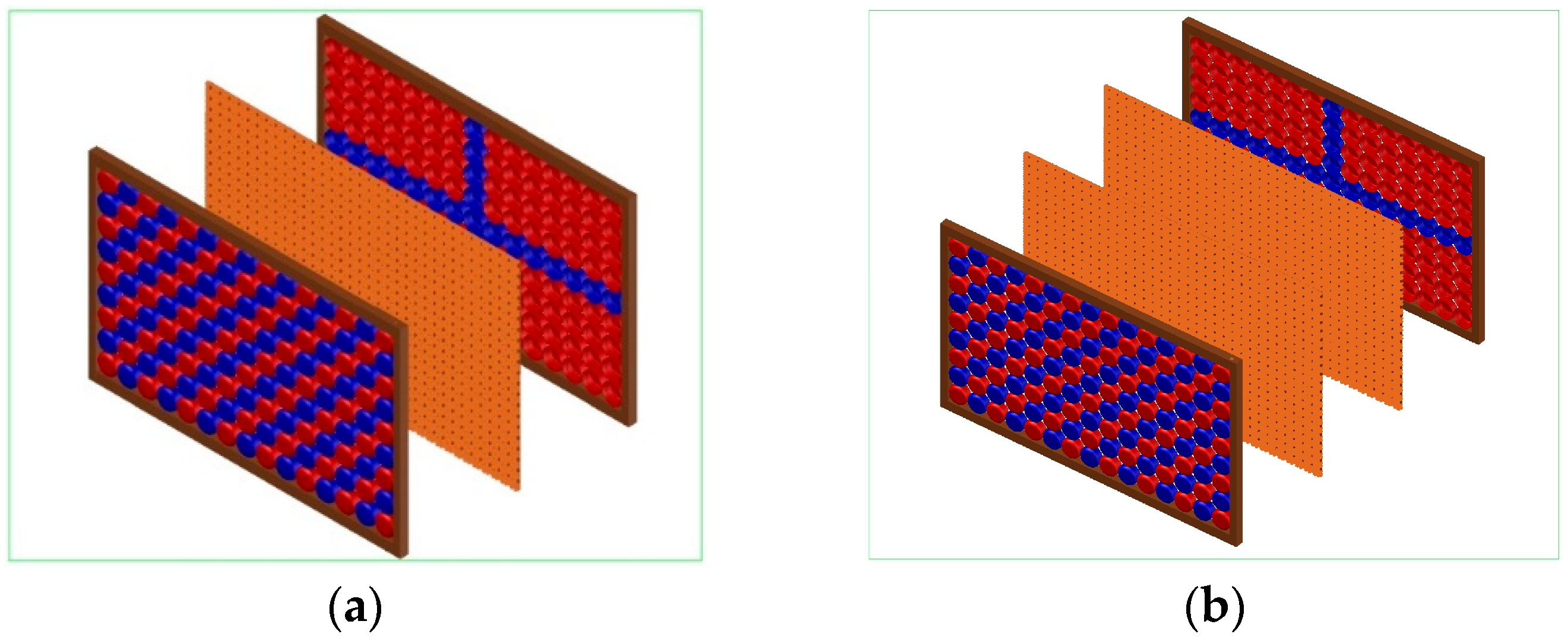

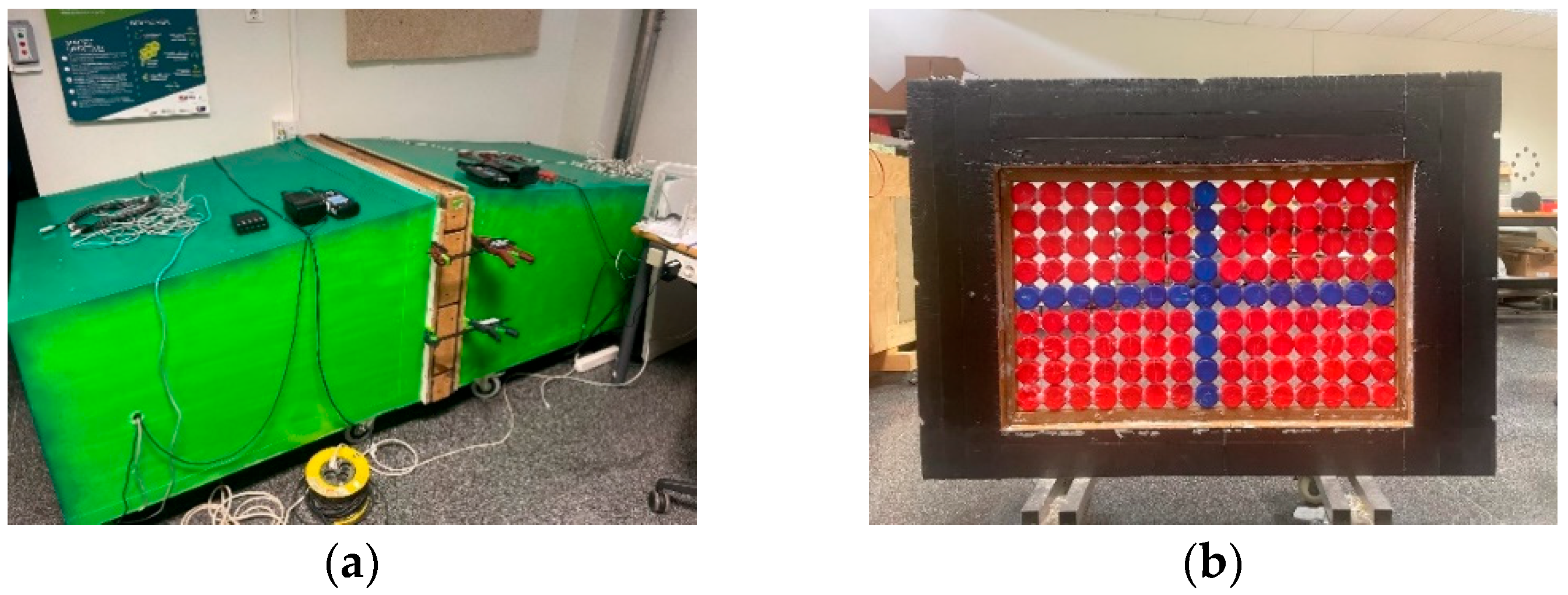
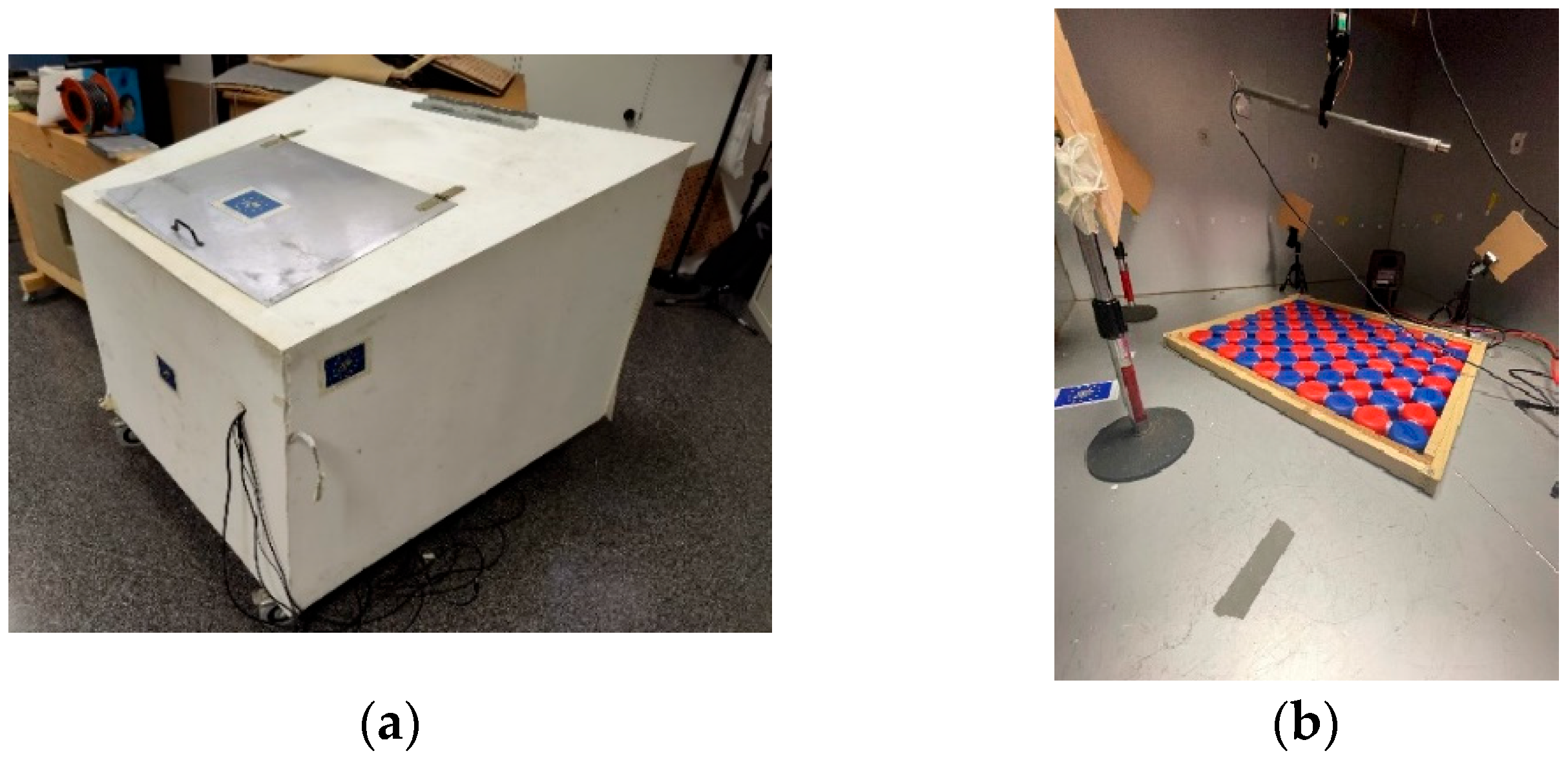


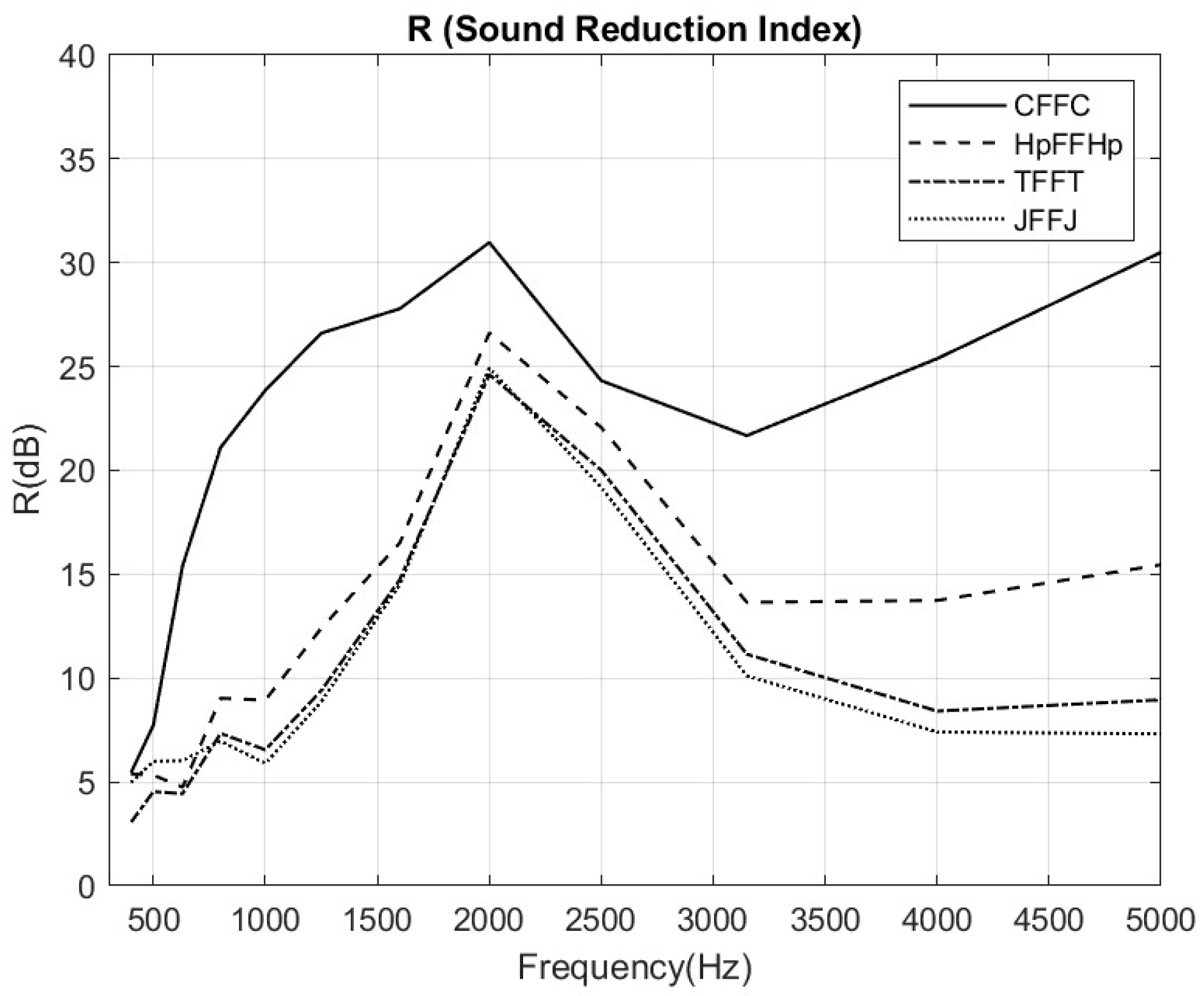

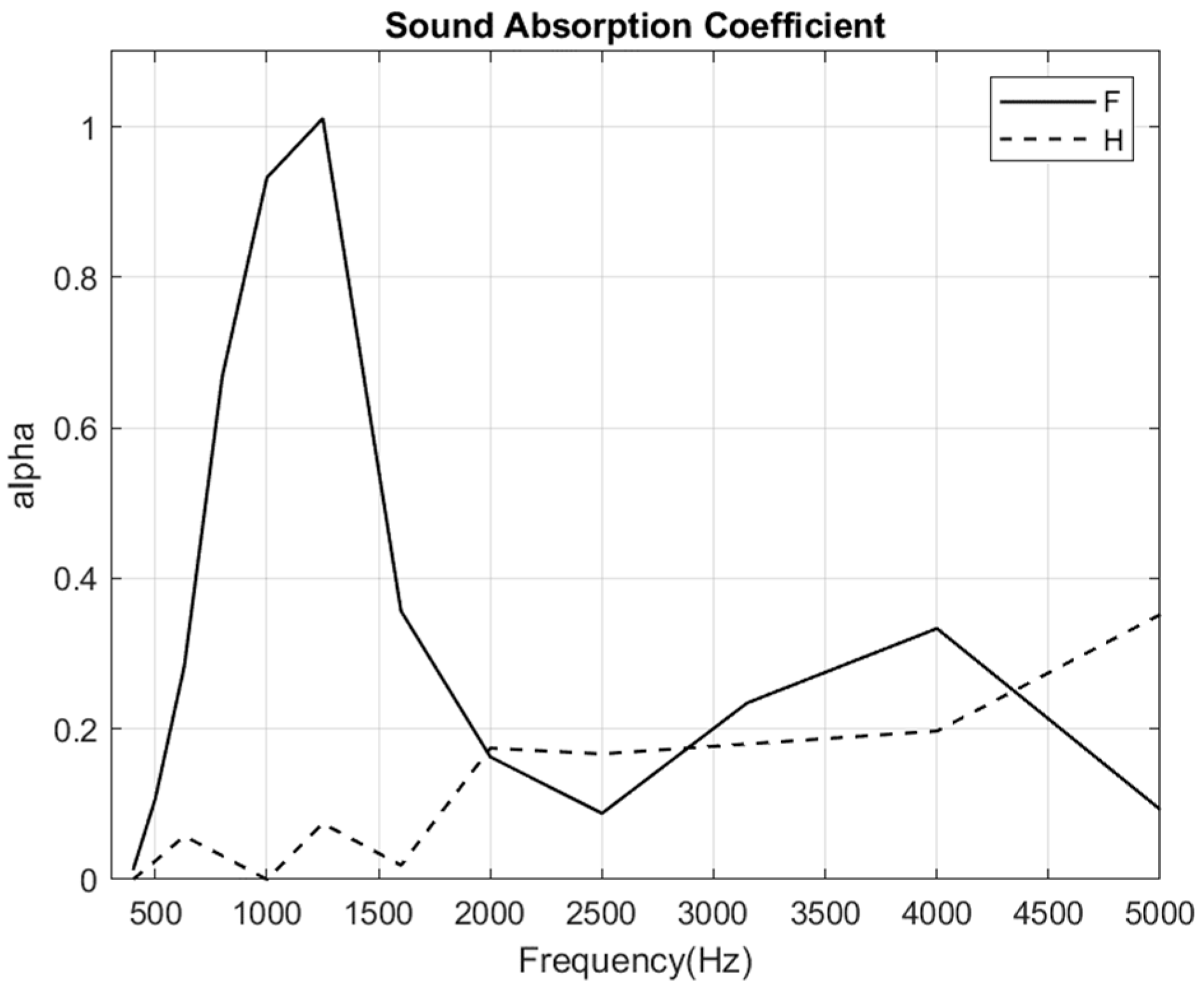
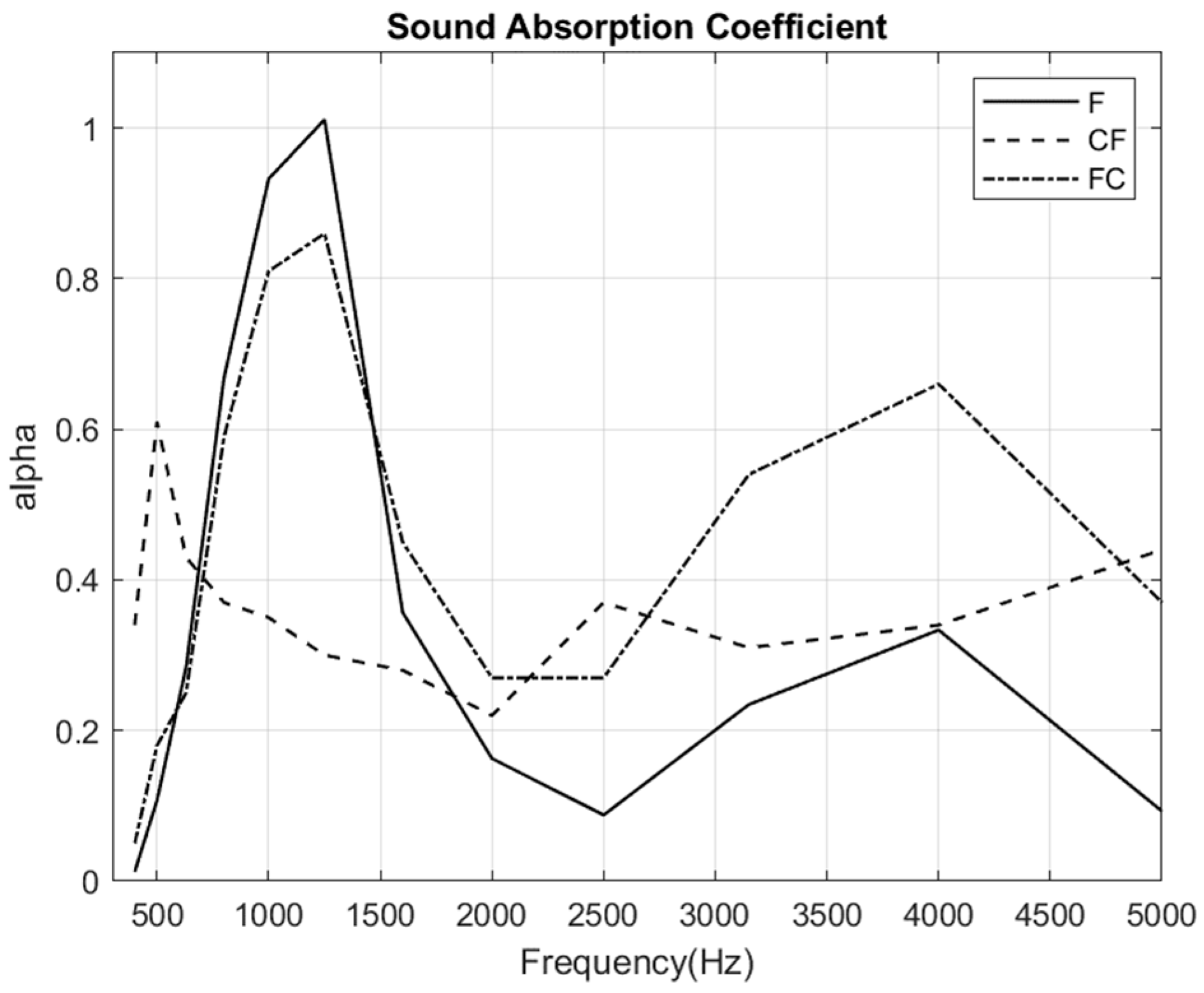
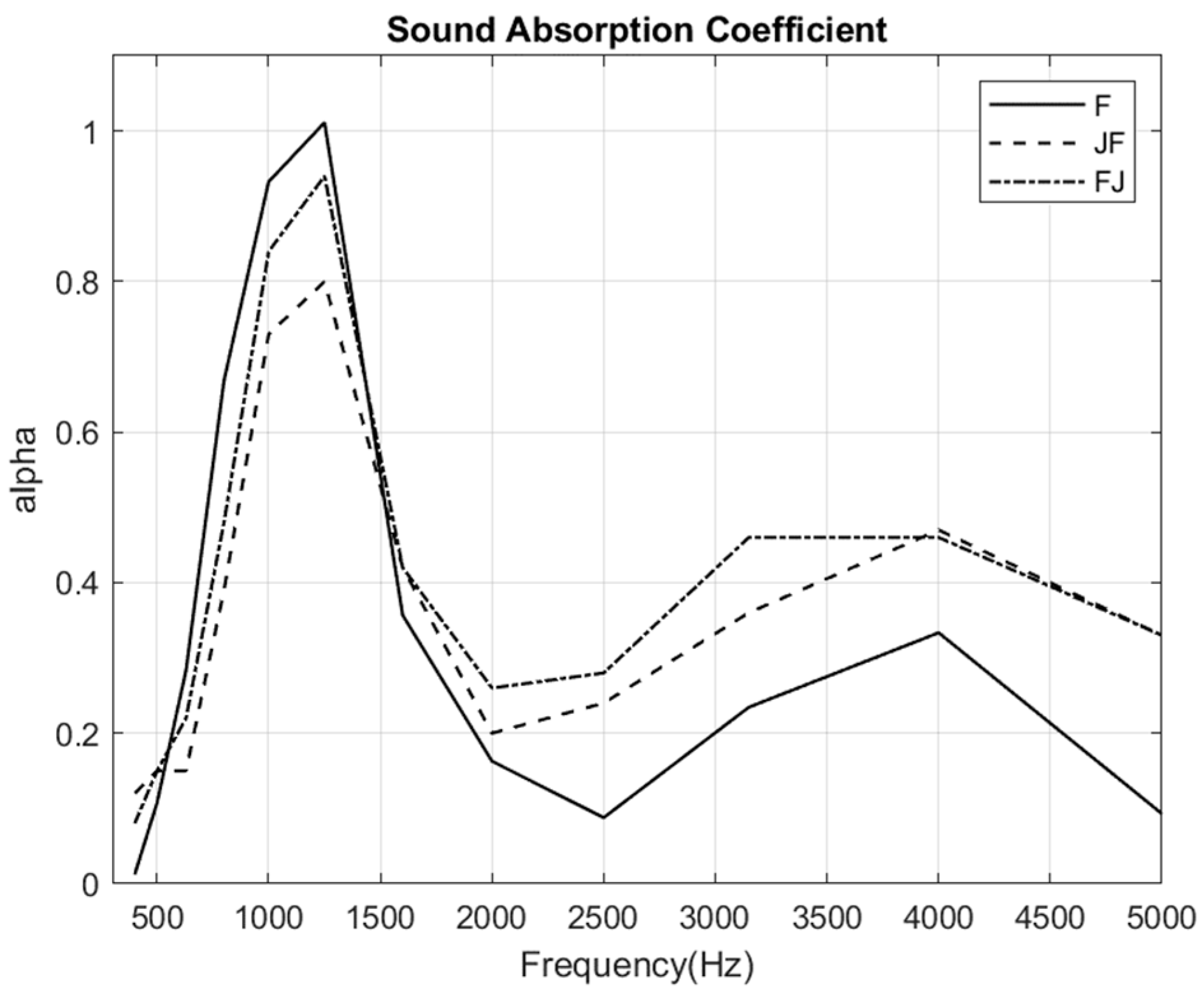
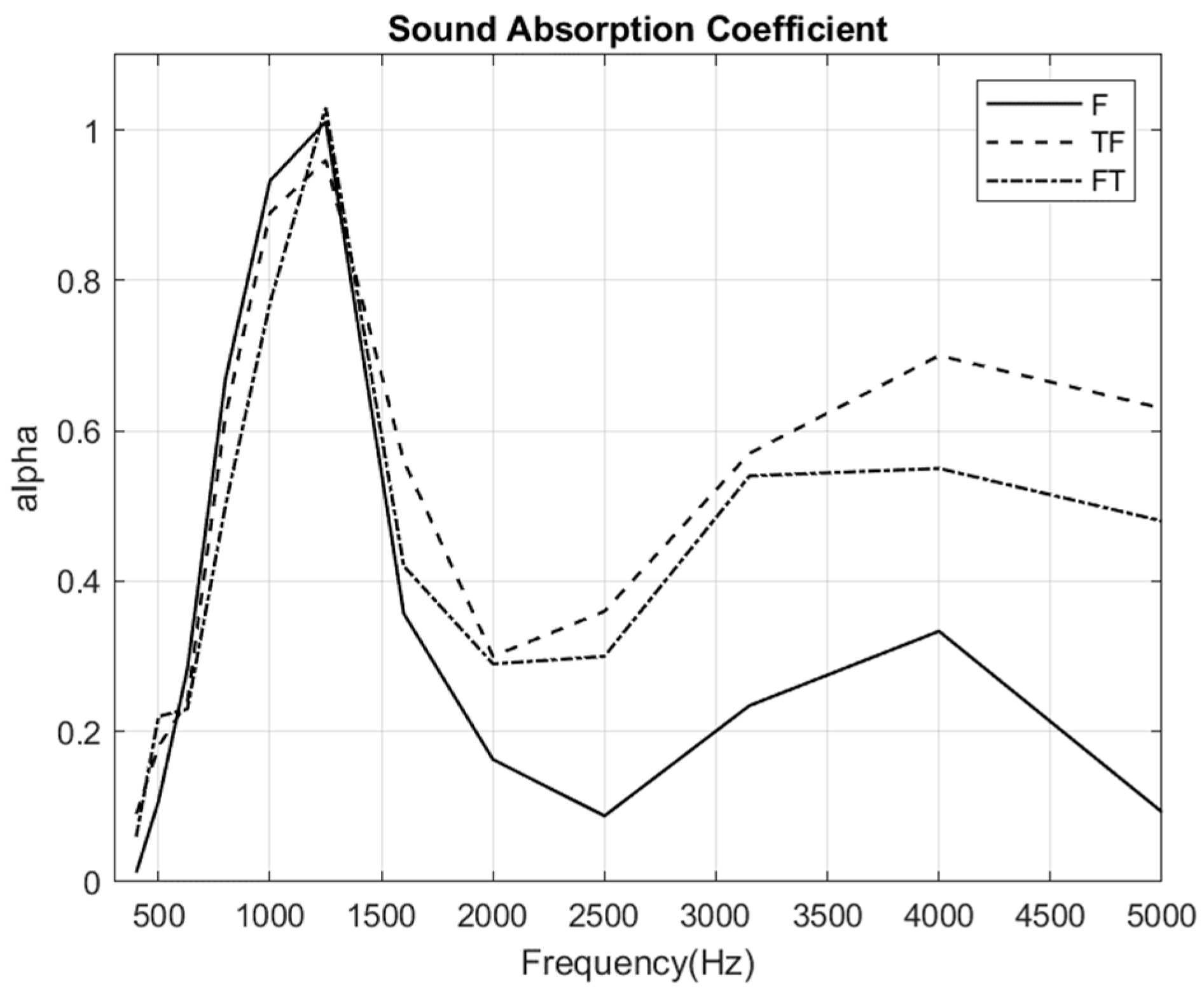
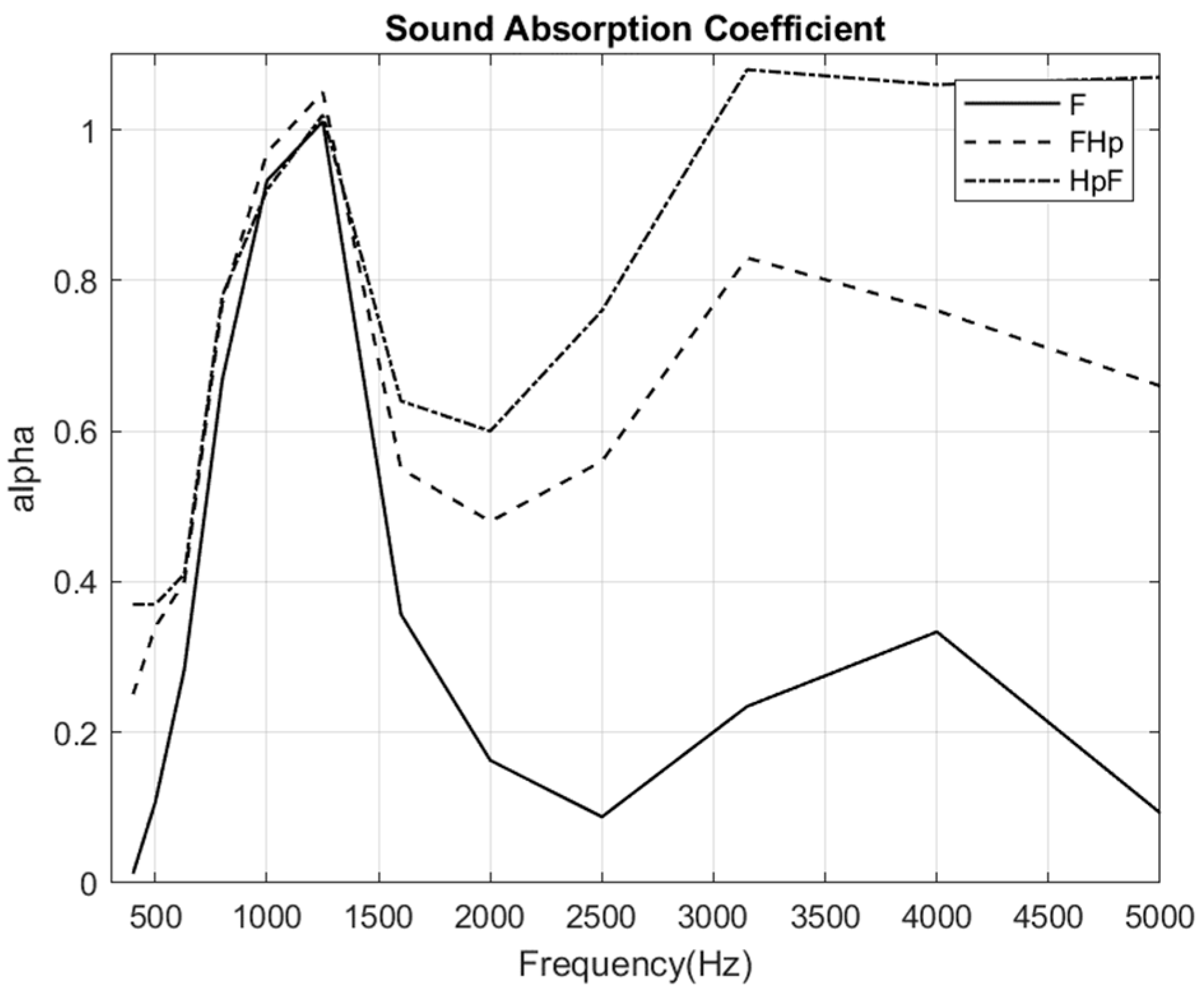
| Material | Reference | Density (kg/m3) | Thickness (mm) |
|---|---|---|---|
| Jute weaving | J | 420 | 0.75 |
| Textile waste | T | 150 | 1.5 |
| Hemp felt | Hp | 242 | 5 |
| Cork board | C | 200 | 5 |
| Configuration | Reference | Thickness (mm) |
|---|---|---|
| Hollow | H | 22 |
| Flat | F | 22 |
| Flat–Flat | FF | 44 |
| Flat–Hollow | FH | 44 |
| Hollow–Flat | HF | 44 |
| Hollow–Hollow | HH | 44 |
| Jute–Jute–Flat | JJF | 23.5 |
| Jute–Flat–Flat–Jute | JFFJ | 45.5 |
| Flat–Jute–Jute–Flat | FJJF | 45.5 |
| Flat–Jute–Flat | FJF | 44.8 |
| Textile–Textile–Flat | TTF | 25 |
| Textile–Flat–Flat–Textile | TFFT | 47 |
| Flat–Textile–Textile–Flat | FTTF | 47 |
| Flat–Textile–Flat | FTF | 45.5 |
| Hemp–Hemp–Flat | HpHpF | 32 |
| Hemp–Flat–Flat–Hemp | HpFFHp | 54 |
| Flat–Hemp–Hemp–Flat | FHpHpF | 54 |
| Flat–Hemp–Flat | FHpF | 49 |
| Cork–Cork–Flat | CCF | 32 |
| Cork–Flat–Flat–Cork | CFFC | 54 |
| Flat–Cork–Cork–Flat | FCCF | 54 |
| Flat–Cork–Flat | FCF | 49 |
| Configuration | Reference | Thickness (mm) |
|---|---|---|
| Hollow | H | 22 |
| Flat | F | 22 |
| Jute–Flat | JF | 22.8 |
| Textile–Flat | TF | 23.5 |
| Hemp–Flat | HpF | 27 |
| Cork–Flat | CF | 27 |
| Flat–Jute | FJ | 22.8 |
| Flat–Textile | FT | 23.5 |
| Flat–Hemp | FHp | 27 |
| Flat–Cork | FC | 27 |
Disclaimer/Publisher’s Note: The statements, opinions and data contained in all publications are solely those of the individual author(s) and contributor(s) and not of MDPI and/or the editor(s). MDPI and/or the editor(s) disclaim responsibility for any injury to people or property resulting from any ideas, methods, instructions or products referred to in the content. |
© 2024 by the authors. Licensee MDPI, Basel, Switzerland. This article is an open access article distributed under the terms and conditions of the Creative Commons Attribution (CC BY) license (https://creativecommons.org/licenses/by/4.0/).
Share and Cite
Del Rey, R.; Crespo Amorós, J.E.; Escales Tur, J.; Alba, J. Study of Acoustic Prototypes Based on Plastic Cap Waste. Buildings 2024, 14, 1652. https://doi.org/10.3390/buildings14061652
Del Rey R, Crespo Amorós JE, Escales Tur J, Alba J. Study of Acoustic Prototypes Based on Plastic Cap Waste. Buildings. 2024; 14(6):1652. https://doi.org/10.3390/buildings14061652
Chicago/Turabian StyleDel Rey, Romina, José Enrique Crespo Amorós, Joan Escales Tur, and Jesús Alba. 2024. "Study of Acoustic Prototypes Based on Plastic Cap Waste" Buildings 14, no. 6: 1652. https://doi.org/10.3390/buildings14061652





